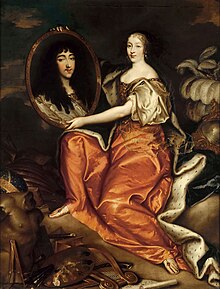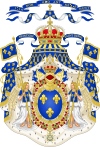Henrietta of England
| Henrietta of England | |||||
|---|---|---|---|---|---|
Basilica of St Denis, France | |||||
| Spouse | |||||
| Issue more... |
| ||||
| |||||
Roman Catholicism prev. Church of England | |||||
Henrietta Anne of England (16 June 1644
Fleeing England with her mother as an infant in the midst of the
Henrietta played an instrumental role in negotiating the Secret Treaty of Dover between France and England against the Dutch Republic in June 1670, the same month as her unexpected death at the age of 26. Jacobite claims to the British throne after Henry Benedict Stuart's death descend from her daughter Anne Marie.
Infancy in England
Henrietta was born on 16 June 1644, on the eve of the
Shortly before Henrietta's birth, her mother had been forced to leave
Life and marriage in France
While living at the French court, Henrietta was given the name Anne in honour of her aunt, the French queen
In February 1649, Henrietta's mother was informed of the

After the Fronde was over, the French court made it a priority to find a bride for the young king of France. Queen Henrietta Maria hinted at the idea of a union between Henrietta and Louis, but Queen Anne rejected the idea, preferring instead her niece by blood,
The impatient Philippe was eager to make sure he married Henrietta as soon as possible, but Queen Henrietta Maria was intent on going to England to sort out her debts, secure a dowry for Henrietta, and prevent the
Henrietta's return to France was delayed by the death from
The marriage started well and Philippe seems to have been a doting husband. A year into the marriage, Henrietta gave birth to a daughter later baptised
Soon after, Louis started an affair with one of Henrietta's
In 1666, her husband's most prominent alleged lover, the

Henrietta has often been praised as a cultured princess, and her correspondence with
Late in 1669, Queen Henrietta Maria died after taking an excessive quantity of opiates as a painkiller.[30] Henrietta was devastated, and the situation was not helped by Philippe's immediate rush to claim all her possessions before she had even been buried.
Secret Treaty of Dover
Henrietta was instrumental in diplomatic negotiations between her native England and adopted France. Her brother
Charles abandoned England's Triple Alliance with Sweden and the Dutch Republic in favour of assisting Louis XIV in conquering the Dutch Republic, which he claimed for his wife Queen Maria Theresa as part of her unpaid dowry. Provided that the conquest was successfully completed, England was promised several very profitable ports along one of the major rivers that ran through the Dutch Republic. The treaty did not become public until 1830.[32] After Henrietta's time in England, she returned to France on 18 June.[33]
Death, burial and aftermath

In 1667, Henrietta began complaining of intermittent, intense pain in her side. Beginning in April 1670, according to reports, she began having digestive problems so severe that she could consume only milk. Henrietta was interred at the 
"Last of all came the members of Monsieur and Madame's household, bearing torches in their hands. A mausoleum, surrounded with altars and silver urns, and adorned with a crowd of mourning allegorical statues, among which Youth, Poetry and Music were conspicuous, had been erected in the centre of the choir. There the coffin rested, covered with cloth of gold, edged with
Henrietta's eldest daughter,
Issue

- Marie Louise d'Orléans (26 March 1662 – 12 February 1689) married Charles II of Spain, no issue.
- Miscarriage (1663).[46]
- Philippe Charles d'Orléans, Duke of Valois (16 July 1664 – 8 December 1666) died in infancy.
- Stillborn daughter (9 July 1665).
- Miscarriage (1666).[46]
- Miscarriage (1667).[46]
- Miscarriage (1668).[47]
- Victor Amadeus II, Duke of Savoy(future king of Sardinia) and had issue.
Ancestry
| Ancestors of Henrietta of England | ||||||||||||||||||||||||||||||||||||||||||||||||||||||||||||||
|---|---|---|---|---|---|---|---|---|---|---|---|---|---|---|---|---|---|---|---|---|---|---|---|---|---|---|---|---|---|---|---|---|---|---|---|---|---|---|---|---|---|---|---|---|---|---|---|---|---|---|---|---|---|---|---|---|---|---|---|---|---|---|
| ||||||||||||||||||||||||||||||||||||||||||||||||||||||||||||||
References
- ^ Barker 1989, p. 75.
- ^ Barker 1989, p. 72.
- ^ Barker 1989, p. 78.
- ^ Cartwright 1900, pp. 1–3.
- ^ Cartwright 1900, p. 3.
- ^ Cartwright 1900, p. 4.
- ^ a b Fraser 2006, p. 32.
- ^ Cartwright 1900, p. 5.
- ^ Cartwright 1900, p. 13.
- ^ Cartwright 1900, p. 18.
- ^ Cartwright 1900, pp. 25–28.
- ^ Fraser 2006, p. 67.
- ^ Cartwright 1900, p. 68.
- ^ Cartwright 1900, p. 62.
- ^ Cartwright 1900, p. 67.
- ^ Cartwright 1900, p. 69.
- ^ Barker 1989, p. 125.
- ^ Cartwright 1900, p. 70.
- ^ Cartwright 1900, p. 81.
- ^ Cartwright 1900, p. 90.
- ^ Fraser 2006, p. 321.
- ^ Cartwright 1900, p. 106.
- ^ Barker 1989, p. 115.
- ^ Mitford 1966, p. 87.
- ^ Cartwright 1900, p. 239.
- ^ Cartwright 1900, p. 179.
- ^ Fraser 2006, p. 76.
- ^ Fraser 2006, p. 77.
- ^ a b c Fraser 2006, p. 155.
- ^ White, Michelle A. (2006). Henrietta Maria and the English Civil Wars. Ashgate Publishing. p. 193.
- ^ Fraser 2006, p. 151.
- ^ Fraser 1979, p. 276.
- ^ Cartwright 1900, p. 336.
- ^ PMID 9659312.
- ^ Fraser 2006, p. 153.
- ^ Cartwright 1900, p. 345.
- ^ H. F. Helmolt, Elisabeth Charlottens Briefe an Karoline von Wales (Elisabeth Charlotte's letters to Caroline of Wales), German edition, Annaberg 1909, p. 289-291, letter of 13 July 1716
- ^ Saint-Simon, Louis de Rouvroy, duc de (1888). The Memoirs of the Duke de Saint-Simon on the Reign of Louis XIV. and the Regency. Vol. 1. Translated by St. John, Bayle (Second ed.). London: Swan, Sonnenschein, Lowrey.
{{cite book}}: CS1 maint: multiple names: authors list (link) - ^ Taylor, Andrew. The Royal Secret. London: Harper Collins. pp. 366–367.
- ^ Cartwright 1900, p. 383.
- ^ Barker 1989, p. 123.
- ^ Fraser 2006, p. 277.
- ^ Baron 1998, p. 215.
- ^ Barker 1989, p. 234.
- ^ Barker 1989, p. 239.
- ^ a b c Weir 2011, p. 254.
- ^ Weir 2011, p. 255.
- ^ a b Louda & Maclagan 1999, p. 27.
- ^ a b Louda & Maclagan 1999, p. 50.
- ^ a b c d Louda & Maclagan 1999, p. 140.
Bibliography
- ISBN 9780801837913.
- Cartwright, Julia (1900). Madame: A life of Henrietta, daughter of Charles I and Duchess of Orléans (Second ed.). London: Seeley and Co. Ltd.
- ISBN 978-0-7538-2293-7.
- ISBN 0-297-77571-5.
- Louda, Jiří; ISBN 978-0-316-84820-6
- ISBN 0-14-023967-7.
- ISBN 978-1-446-44911-0.

